
 i_need_contribute
i_need_contribute
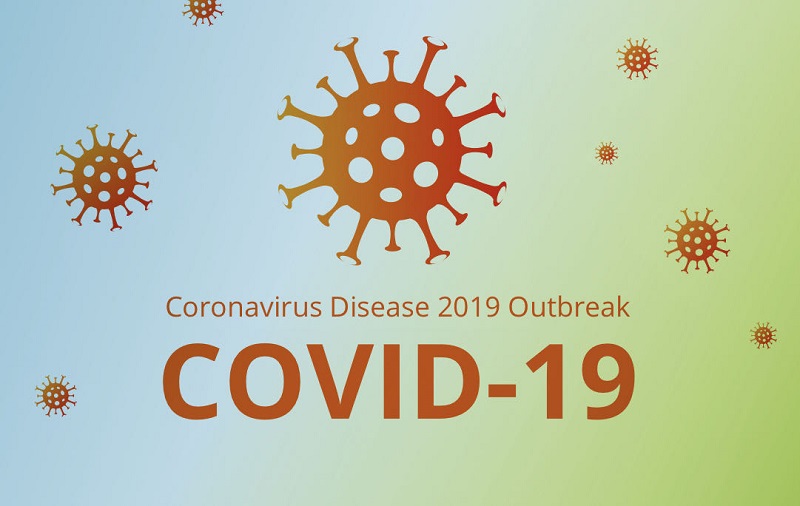
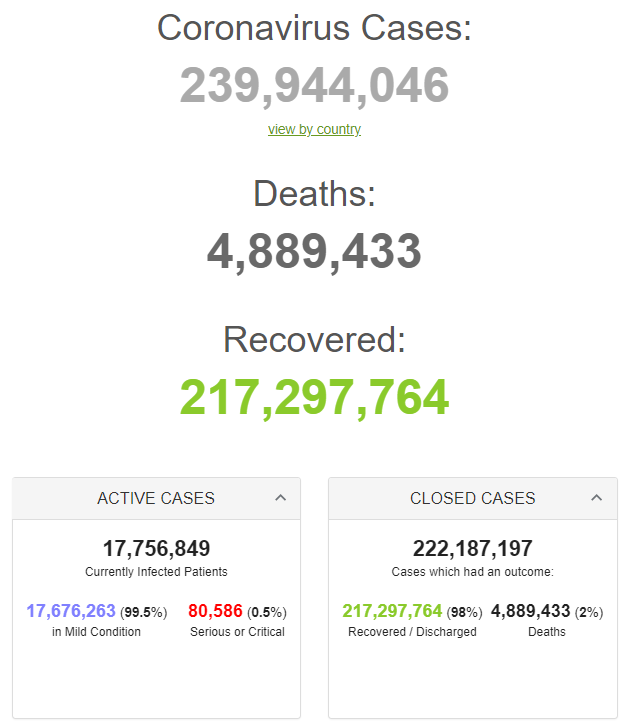
|
Country, |
Total |
New |
Total |
|
World |
239,908,482 |
+442,108 |
4,888,761 |
|
45,547,920 |
+99,775 |
739,778 |
|
|
34,019,680 |
+19,180 |
451,469 |
|
|
21,597,949 |
+7,852 |
601,643 |
|
|
8,272,883 |
+42,776 |
138,080 |
|
|
7,861,681 |
+28,717 |
219,329 |
|
|
7,540,223 |
+31,248 |
66,841 |
|
|
7,069,089 |
+5,578 |
117,173 |
|
|
5,742,083 |
+12,298 |
123,275 |
|
|
5,268,653 |
+1,314 |
115,582 |
|
|
4,980,206 |
+2,758 |
86,869 |
|
|
4,975,656 |
+1,256 |
126,726 |
|
|
4,707,087 |
+2,772 |
131,421 |
|
|
4,354,487 |
+12,309 |
95,265 |
|
|
4,231,046 |
+1,233 |
142,811 |
|
|
3,732,429 |
+7,187 |
282,773 |
|
|
2,928,065 |
+2,640 |
75,958 |
|
|
2,913,880 |
+942 |
88,466 |
|
|
2,690,455 |
+7,181 |
40,069 |
|
|
2,578,394 |
+16,309 |
59,523 |
|
|
2,361,529 |
+7,950 |
27,593 |
|
|
2,186,246 |
+891 |
199,746 |
|
|
2,033,005 |
+3,716 |
18,227 |
|
|
2,028,115 |
+1,766 |
22,655 |
|
|
1,740,428 |
+10,064 |
17,917 |
|
|
1,711,935 |
+611 |
17,986 |
|
|
1,702,939 |
+1,512 |
30,521 |
|
|
1,670,240 |
+2,665 |
28,367 |
|
|
1,664,725 |
+733 |
37,578 |
|
|
1,564,019 |
+518 |
27,730 |
|
|
1,398,264 |
+15,733 |
40,461 |
|
|
1,311,295 |
+1,187 |
7,959 |
|
|
1,269,002 |
+2,440 |
25,713 |
|
|
1,260,669 |
+1,021 |
28,173 |
|
|
1,077,186 |
+828 |
18,065 |
|
|
1,024,497 |
+6,699 |
8,892 |
|
|
940,503 |
+581 |
14,500 |
|
|
926,320 |
+2,354 |
7,956 |
|
|
908,847 |
+1,707 |
11,613 |
|
|
849,691 |
+3,461 |
20,869 |
|
|
837,255 |
+1,286 |
10,841 |
|
|
830,725 |
+814 |
30,330 |
|
|
803,878 |
+326 |
11,261 |
|
|
766,542 |
+2,614 |
11,135 |
|
|
738,152 |
+126 |
2,116 |
|
|
710,322 |
+226 |
25,053 |
|
|
684,706 |
+2,312 |
15,241 |
|
|
645,195 |
+4,837 |
9,332 |
|
|
631,642 |
+692 |
8,400 |
|
|
583,201 |
+1,703 |
14,177 |
|
|
563,813 |
+2,060 |
4,336 |
|
|
549,084 |
+1,170 |
6,744 |
|
|
547,761 |
+57 |
8,753 |
|
|
531,129 |
+3,327 |
22,004 |
|
|
528,415 |
+680 |
13,408 |
|
|
504,601 |
+480 |
18,806 |
|
|
495,332 |
+1,265 |
6,709 |
|
|
482,803 |
+1,573 |
18,222 |
|
|
469,569 |
+129 |
7,275 |
|
|
460,277 |
+33 |
16,207 |
|
|
429,886 |
+2,406 |
12,772 |
|
|
421,057 |
+2,022 |
8,829 |
|
|
415,938 |
+756 |
4,279 |
|
|
412,196 |
+38 |
2,455 |
|
|
408,021 |
+2,051 |
5,306 |
|
|
390,394 |
+160 |
6,065 |
|
|
387,393 |
+1,441 |
4,667 |
|
|
370,968 |
+706 |
10,045 |
|
|
367,379 |
+668 |
4,077 |
|
|
365,840 |
+789 |
2,674 |
|
|
357,801 |
+2,493 |
5,308 |
|
|
356,772 |
+929 |
6,103 |
|
|
348,088 |
+724 |
4,832 |
|
|
335,742 |
+1,584 |
2,605 |
|
|
330,869 |
+2,565 |
1,482 |
|
|
314,977 |
+861 |
17,806 |
|
|
310,776 |
+2,052 |
7,105 |
|
|
304,013 |
+14 |
4,103 |
|
|
275,862 |
+59 |
1,390 |
|
|
275,077 |
+1,217 |
5,646 |
|
|
251,483 |
+170 |
5,198 |
|
|
237,662 |
+83 |
607 |
|
|
209,411 |
+15 |
3,657 |
|
|
208,404 |
+251 |
2,761 |
|
|
204,900 |
+110 |
5,862 |
|
|
195,542 |
+410 |
6,875 |
|
|
195,029 |
+399 |
884 |
|
|
179,492 |
+63 |
2,624 |
|
|
179,371 |
+385 |
1,276 |
|
|
176,172 |
+508 |
2,788 |
|
|
175,890 |
+2,236 |
2,836 |
|
|
167,828 |
+1,228 |
1,404 |
|
|
120,120 |
+142 |
560 |
|
|
45,592 |
+719 |
994 |
Retrieved from: https://www.worldometers.info/coronavirus/
By Alistair Smout

Students attend a lesson at Weaverham High School, as the coronavirus disease (COVID-19) lockdown begins to ease, in Cheshire, Britain, March 9, 2021. REUTERS/Jason Cairnduff/File Photo
COVID-19 infections in children in England rose in September after schools returned from summer holidays, helping to keep cases high even as there was a fall among adults, a large prevalence study showed on Thursday.
The REACT-1 study, led by Imperial College London, is the latest to find that more children are getting infected with COVID-19 following the reopening of schools at the start of September. read more
Infection numbers in Britain are currently much higher than in other western European countries, with more than 30,000 new cases reported every day this month, but have not risen above summer levels following the return of schools in England despite the higher infection rates in children.
The study found that prevalence in 13 to 17-year-olds was 2.55% between Sept 9-27, with prevalence in those aged 5 to 12 at 2.32%. Prevalence for every adult age group was estimated below 1%.
The study found that the epidemic was growing among those under 17, with an estimated reproduction "R" number of 1.18. An R number above 1 implies exponential growth, while a number below 1 implies the epidemic is shrinking.
The epidemic was estimated to be shrinking in 18-54 year olds, with an R number of 0.81, while the epidemic was broadly steady among those over 55.
While around 90% of over 18s have had one dose of COVID-19 vaccine, vaccination rates of children are much lower, and broad vaccination of those aged 12-15 only began last month.
"Prevalence was high and increasing in school aged children during September," Paul Elliott, who led the study, told reporters.
"Increased vaccination uptake in school-aged children, and the unvaccinated or partially vaccinated adults will help reduce the potential for transmission."
The study is intended to give an estimate of infection numbers that are unaffected by trends in people coming forward to be tested with COVID symptoms.
There was overall prevalence of 0.83% out of 100,527 valid swabs submitted, higher than the 0.63% recorded by the study in July before cases peaked later that month.
Retrieved from: https://www.reuters.com/world/uk/english-school-return-spurred-covid-children-cases-fell-adults-study-2021-10-13/
The World Health Organisation on Wednesday proposed 26 experts to form its new Scientific Advisory Group for the Origins of novel pathogens, including several who served on its mission to Wuhan, China, to probe the source of the SARS-CoV-2 coronavirus.
The statement named the 26 proposed members ahead of a two-week period of public consultation, including Marion Koopmans, Thea Fischer, Hung Nguyen and Chinese animal health expert Yang Yungui, who took part in the joint investigation this year.
"Understanding where new pathogens come from is essential for preventing future outbreaks with epidemic and pandemic potential, and requires a broad range of expertise. We are very pleased with the calibre of experts selected for SAGO from around the world," WHO director-general Tedros Adhanom Ghebreyesus said in a statement.
The WHO launched the request for applications last August, saying it was looking for the greatest scientific minds to advise on investigations into new high-threat pathogens that jump from animals to humans and could spark the next pandemic.
Retrieved from: https://www.reuters.com/business/healthcare-pharmaceuticals/who-panel-origins-new-pathogens-includes-wuhan-probe-members-2021-10-13/
By Carl Zimmer and Noah Weiland
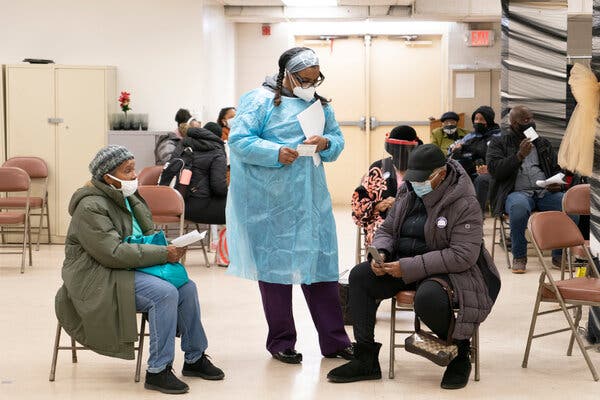
At at Johnson & Johnson coronavirus vaccine event at the New Hope Baptist Church in Newark, N.J., in March.Credit...James Estrin/The New York Times
People who received a Johnson & Johnson coronavirus vaccine may be better off with a booster shot from Moderna or Pfizer-BioNTech, according to preliminary data from a federal clinical trial published on Wednesday.
That finding, along with a mixed review by the Food and Drug Administration of the case made by Johnson & Johnson for an authorization of its booster, could lead to a heated debate about how and when to offer additional shots to the 15 million Americans who have received the single-dose vaccine.
The agency’s panel of vaccine advisers will meet Thursday and Friday to vote on whether to recommend that the agency allow Moderna and Johnson & Johnson to offer booster shots.
Despite the questions raised by the new data on the strength of Johnson & Johnson’s boosters, some experts anticipated that the agency would clear the shots anyway, since the effectiveness of the one-shot vaccine is lower than that of the two-dose mRNA vaccines made by Moderna and Pfizer-BioNTech. And the broader public may also be expecting the authorizations, given the Biden administration’s push for boosters from all brands.
Once the agency authorized a booster from Pfizer-BioNTech last month, “the die was cast,” said John Moore, a virologist at Weill Cornell Medicine.
The Pfizer and Moderna vaccines are by far the most used in the United States, with more than 170 million people in the United States fully immunized with either one or the other vaccine. When Johnson & Johnson’s was authorized in February, public health experts were eager to deploy the “one-and-done” option, particularly in communities with poor access to health care. But the shot’s popularity plummeted when the F.D.A. later paused its use to investigate rare blood clotting cases.
For those who have received the Johnson & Johnson vaccine, the timing of a booster authorization — of any brand — is still uncertain. The F.D.A. panel is set to vote Friday only on whether the agency should permit a second dose of the Johnson & Johnson vaccine, a scenario the Centers for Disease Control and Prevention’s own vaccine advisory committee will discuss next week. If both agencies believe an additional dose should be offered, people could seek them out as early as next week.
Whether the F.D.A. might authorize the mix-and-match approach, and how, is unclear. The strategy will be discussed at the agency panel’s meeting on Friday, but no vote will be taken. If regulators eventually believe there is enough scientific support for the approach, they would likely need to update the authorization language of the Moderna and Pfizer-BioNTech vaccines to allow for their use in people who initially received Johnson & Johnson’s.
In a study conducted by the National Institutes of Health, researchers organized nine groups of roughly 50 people each. Each group received one of the three authorized vaccines, followed by a booster. In three groups, volunteers received the same vaccine for a boost. In the other six, they switched to a different brand.
The researchers found that those who got a Johnson & Johnson shot followed by a Moderna booster saw their antibody levels rise 76-fold within 15 days, whereas those who received another dose of Johnson & Johnson saw only a fourfold rise in the same period. A Pfizer-BioNTech booster shot raised antibody levels in Johnson & Johnson recipients 35-fold.
The authors cautioned about the study’s small size and noted that they did not follow the volunteers long enough to identify rare side effects.
Retrieved from: https://www.nytimes.com/2021/10/13/health/johnson-vaccine-booster-fda.html
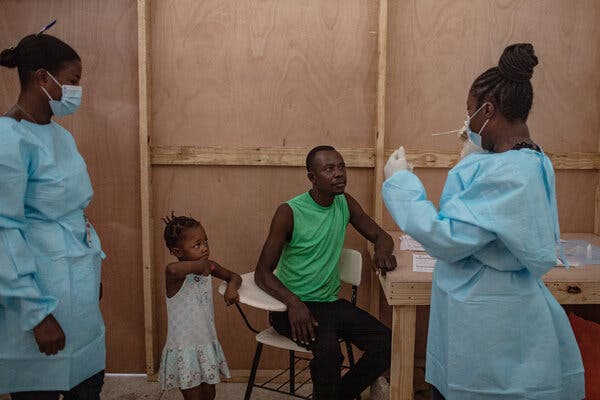
Nurses performing Covid-19 tests in July on people displaced by political upheaval in Port-au-Prince, Haiti.Credit...Victor Moriyama for The New York Times
In Guatemala, shortages of syringes have slowed vaccination efforts. In Haiti, logistical and security challenges after the devastating Aug. 14 earthquake have contributed to making it the country with the lowest vaccination coverage in the world.
And across the Caribbean, countries are grappling with unequal distribution of doses and vaccine hesitancy, World Health Organization officials warned today in an online news conference.
An “important challenge that the Caribbean is facing — English-speaking countries and French- speaking countries and territories — is vaccine hesitancy,” said Dr. Sylvain Aldighieri, the Covid-19 incident manager at the Pan American Health Organization, which is part of the W.H.O.
“Even if some territories of the Caribbean are leading the regional effort in terms of vaccination coverage, we can say that the vaccine uptick is suboptimal in most of the Caribbean countries,” he said.
The W.H.O. has set a goal of having every country in the world vaccinate at least 40 percent of its population by the end of the year. Four of the six countries in the Americas that have yet to reach the 20 percent threshold are in the Caribbean: Haiti, Jamaica, St. Vincent and the Grenadines, and St. Lucia. The other two — Nicaragua and Guatemala — are in Central America.
“Across all these countries, vaccine availability due to unequal distribution of doses has been a central challenge,” said Dr. Carissa F. Etienne, the Pan-American agency’s director.
But several of the countries are also “facing their own unique barriers,” she added, like the shortage of syringes in Guatemala.
At the same time, Jamaica has had to cope with supply delays.
Haiti, where the August earthquake killed at least 2,200 people, has fully inoculated less than 1 percent of its population.
“The sociopolitical situation in Haiti is still tense, and that has negatively impacted” vaccination efforts, said Ciro Ugarte, the Pan-American agency’s director of health emergencies.
Countries in Latin America and the Caribbean receive vaccines through bilateral agreements with manufacturers as well as through the United Nations-backed Covax program and donations from countries with excess doses. The Pan-American agency has also sealed deals for countries to buy millions of vaccine doses from China’s Sinopharm and Sinovac, as well as from AstraZeneca.
Although the numbers of Covid cases in much of Latin America and the Caribbean are declining, several islands in the Caribbean are seeing increases.
Barbados, for example, is reporting the highest number of infections and deaths since the pandemic started, said Dr. Etienne, the agency’s director. The Dominican Republic, Haiti, the Cayman Islands, Antigua and Barbuda, and Anguilla are also reporting increases in cases.
“In the eastern Caribbean, health services have been — or are still — overwhelmed by the influx of patients requiring hospitalization,” Dr. Aldighieri said. He also noted that the situation was a sharp contrast to last year, when most of the Caribbean island countries were largely able to avoid widespread transmission of the virus.
Despite vaccine hesitancy, 39 percent of the population across Latin America and the Caribbean have been fully vaccinated against Covid-19, Dr. Etienne said. That is sharply higher than in Africa, where less than 5 percent of the population has been fully vaccinated, according to the Africa Centers for Disease Control and Prevention.
As more vaccines start to flow to the region, though, it’s important for countries “to make the necessary preparations so these doses can be used as quickly as possible,” Dr. Etienne said.
Retrieved from: https://www.nytimes.com/2021/10/13/world/americas/haiti-covid-vaccinations-caribbean.html
By Amy Qin
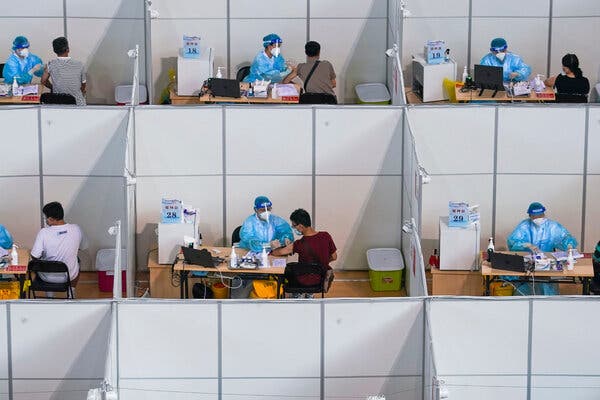
People getting Covid-19 vaccinations in Nanjing, in China’s Jiangsu Province, in August.Credit...Li Bo/Xinhua, via Associated Press
Chinese authorities are rolling out third shots of coronavirus vaccines for high-risk groups in at least 10 regions, according to state media, as the country races to meet its goal of fully vaccinating 80 percent of its population by the end of the year.
After a series of outbreaks of the Delta variant, Wang Huaqing, chief expert for China’s immunization program at the Chinese Center for Disease Control, recommended last month that additional shots be administered to people in frontline professions, including medical workers; people with weaker immune systems; those age 60 or older; and travelers going to countries deemed at high risk.
Chinese health officials have said that further studies were still needed to determine whether the rest of the population would benefit from getting an additional shot.
By Sunday, more than 40,000 people in Hubei, the province encompassing Wuhan where the virus first emerged, had received booster shots, according to state media reports. In the northeastern province of Heilongjiang, which had a flare-up of the Delta variant last month, local health officials said that people who got the booster shot would see their government-issued health codes upgraded to reflect their strengthened immune status.
Last month, China announced that it had fully inoculated 1 billion people, or about 71 percent of its population of 1.4 billion. The country has administered 2.21 billion doses, more than twice that of India, which is ranked second for shots given, according to Our World in Data, which tracks vaccination figures.
Despite its high vaccination rate, China has shown no signs of abandoning its “zero Covid” strategy, and has instead continued to employ a mix of stringent border controls, mass testing and snap lockdowns to tame outbreaks.
On Monday, a panel of experts advising the World Health Organization recommended that an additional dose be administered to people over 60 who were inoculated with vaccines made by the Chinese companies Sinopharm and Sinovac. The panel cited evidence from studies in Latin America that immune protection from the Chinese vaccines wanes significantly over time. While the experts also recommended additional doses of the seven W.H.O.-authorized vaccines for people with weaker immune systems, the Chinese-made shots were the only ones that were singled out for expanded use for older people in the general population.
In a nod to concerns that poorer countries are struggling to offer first doses to their populations while some wealthier countries administer boosters, the W.H.O. panel recommended that health authorities using the Sinovac and Sinopharm vaccines aim to fully inoculate older populations before administering third doses.
Authorities in Turkey have already been allowing people inoculated with Sinovac’s vaccine to get an additional shot of the Pfizer vaccine to help facilitate travel to countries where the Chinese vaccines have not been approved.
More than 1 billion Chinese-made doses have been administered in over 90 countries outside China, though outbreaks in several countries over the summer have raised questions about the efficacy of the shots at preventing the spread of the virus, especially new variants.
The concerns have not slowed China’s efforts to engage in vaccine diplomacy. Last month, the Pan American Health Organization struck a deal with Sinovac to buy millions of Covid-19 vaccines for countries in Latin America and the Caribbean where access to vaccines has been highly uneven.
Retrieved from: https://www.nytimes.com/live/2021/10/13/world/covid-delta-variant-vaccine/china-boosters-covid
· Malfunctioning NHS app for Covid vaccine status causes travel delays. Travellers have been blocked from boarding flights and ferries for trips abroad after a four-hour outage of England’s NHSapp left people unable to access a Covid pass to prove their vaccine status.
· Scientists abused and threatened for discussing Covid, global survey finds. Scientists around the world have received threats of death and sexual assault after speaking to the media about Covid-19, a survey by Nature magazine revealed.
· The UK records 136 deaths and 42,776 new Covid-19 cases.
· Oliver Dowden, the chair of the Conservative party, said he was “very sorry” and admitted “we didn’t get everything right” regarding the handling of the Coronavirus pandemic.
· Russia has set a record for the number of Covid deaths in a 24-hour period for the second day running. Wednesday’s official toll of 984 is slightly higher than yesterday’s then-record 973 deaths.
· A landmark report found the UK government’s management of the outbreak was one of the worst public health failures in British history.
· After a 19-month travel ban, the US announced it will reopen its land borders with Canada and Mexico for non-essential travel.It’s a huge relief for families who have been separated since the beginning of the pandemic and comes after multiple countries pressed the US for months to ease restrictions.
Retrieved from: https://www.theguardian.com/world/coronavirus-outbreak